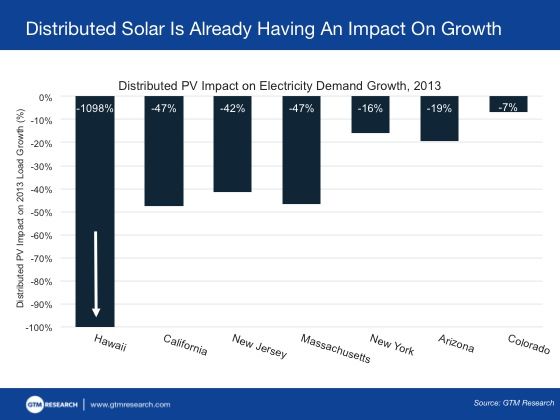The notion that large numbers of electricity consumers will unplug from the power grid doesn't hold up to scrutiny, according to an energy efficiency advocacy group.
The American Council for an Energy-Efficient Economy ran the numbers on electricity consumption projections and concluded that U.S. utilities are largely safe from disruptive defections -- at least for the time being. The reason is simple: people still need energy.
Even with aggressive energy-efficiency measures and rapid solar growth, energy consumption would only go down 10 percent over the next 25 to 30 years, ACEEE concluded in a report published on Wednesday. That’s significant, but not enough to kill off utilities, said co-author Steven Nadel.
In more likely scenarios, energy consumption in the U.S. will grow slightly or be flat over the coming years. Falling prices do make solar PV more compelling in general, but Nadel noted that many don’t have the available rooftop space. “Even in the most extreme case, sales can go down, but pretty modestly,” he said.

Source: ACEEE
That's not to say that utilities have nothing to worry about. Flat or minor load growth means that utilities, whose stock investors buy for the regular dividend, can't count on making profits by selling more kilowatt-hours. Also, distributed generation is indeed spreading and will continue to cut into the amounts that customers pay utilities every month.
As GTM Research VP Shayle Kann pointed out in a recent presentation, distributed resources like solar are already eating away at demand, as the following chart shows.

Source: GTM Research
The ACEEE report collects a number of ideas for new services utilities can offer to compensate for lost revenues. Helping customers improve their energy efficiency, as many utilities are ready are doing, is one obvious service utilities could offer, Nadel said.
In a survey of thousands of consumers, ACEEE found they want more products and services to lower their energy usage. When asked, “If your electric utility was given a grant to improve part of their business, which would you most like to see them invest in?” almost half said efficiency, 26 percent said cleaner power and 19 percent said better reliability.
Distributed generation is also a potential new revenue source, but more so with commercial customers than residential solar. A utility could, for example, help a business or university install and operate local generation and control the system to provide demand response and other services to the grid.
In this future, utilities could evolve into “systems integrators” that coordinate operation of many distributed resources and provide customized services and financing -- a model that is increasingly being recognized in the U.S. and has already been rolled out in New York.
For more on how New York regulators are embracing the "system integrator" model, listen to a recent Energy Gang podcast on the topic:
"We see the utility sweet spot in places like combined heat and power and more community-scale distributed generation systems," said Nadel. "As systems get large and more sophisticated, they start to resemble the power plants they've owned and operated for the last century, and they may well have an...advantage" in that domain.
A number of utilities are experimenting with these types of projects, but regulations need to catch up with new business models. The challenge is setting the rules so that utilities can earn money by offering distributed generation services, while maintaining a competitive marketplace that doesn't give utilities an unfair advantage, Nadel said. In some cases, utilities could put distributed energy projects in the rate base. A hospital microgrid, for example, provides a societal benefit, so regulators may allow costs to be shared by all of the utility’s customers.
Also crucial to utilities' future are new rate structures. Some have proposed phasing out volume-based pricing and increasing the fixed fees customers pay in order to shift the financial incentives away from selling more energy. But Nadel warns that power customers still need price signals to encourage efficiency, such as demand charges during peak hours and time-of-use pricing. If fixed prices are too high, then consumers will have a stronger incentive to install solar and batteries and disconnect from the grid.
It’s worth noting that only about half of the states in the U.S. have regulations to decouple load growth from revenues, according to Nadel. Instead of earning money by selling more energy, utilities get some sort of financial payout for achieving regulator-set efficiency targets. It’s in those states, such as New York and California, that utilities will invent new services and business models. Utilities working under the volume-based pricing model will likely resist change even as more distributed energy technologies take hold.
Regardless of their location, electric utilities should start planning changes they will implement over the next eight years and begin to run experiments, Nadel said. “Some [experiments] will work and some won’t. Some will be successful, and others will follow them,” he said. “But if you’re counting on higher loads for profit growth, that’s not a good business plan.”



